Deliverables
Index
- Deliverable 2.4 Standardisation Strategy
- Deliverable 2.5 Report on clustering activities
- Deliverable 3.1 Guideline on ARCH co-creation approach
- Deliverable 3.2 Local partnership and work plans: Bratislava, Camerino, Valencia and Hamburg
- Deliverable 3.3 City baseline report
- Deliverable 3.4 Report on co-creating the information system
- Deliverable 3.6 Report on co-creating the ARCH HUB and ARCH RAD
- Deliverable 3.7 ARCH D3.7 Case studies report - Experiences and lessons learnt
- Deliverable 4.1 Sensing and Repositories
- Deliverable 4.2 Historic Area Information System
- Deliverable 4.3 Threats and Hazard Information System
- Deliverable 4.4 Knowledge Information Management System for Decision Support
- Deliverable 5.1 Hazard models for impact assessment
- Deliverable 5.2 Handbook on Heritage Asset Vulnerability
- Deliverable 5.3 CIPCast DSS modification and integration
- Deliverable 5.4 IoT Platform for Digital Twin
- Deliverable 6.1 ARCH Resilience Measures Inventory Concept and User Guide
- Deliverable 6.2 Assessment of long-term implementation options
- Deliverable 6.3 Inventory & Characterization Report of funding measures
- Deliverable 6.4 Resilience Pathway Handbook
- Deliverable 7.1 State-of-the-art reports of concepts, approaches, standards and technologies
- D7.1 Report 1: Historic areas, conservation practices, and relevant regulations/policies
- D7.1 Report 2: Disaster risk management, emergency protocols, and post-disaster response
- D7.1 Report 3: Building back better
- D7.1 Report 4: Decision support frameworks and technologies
- D7.1 Report 5: Gender aspects in conservation and regulation of historic areas, disaster risk management, emergency protocols, post-disaster response techniques, and techniques for building back better
- D7.1 Report 6: Existing standards and regulatory frameworks
- D7.1 Combined Glossary of Definitions and Terms for ARCH
- Deliverable 7.2 Good Practices in Building Cultural Heritage Resilience
- Deliverable 7.3 ARCH Disaster Risk Management Framework
- Deliverable 7.4 End-user requirements to ARCH tools and methodologies
- Deliverable 7.6 System design, realisation, and integration
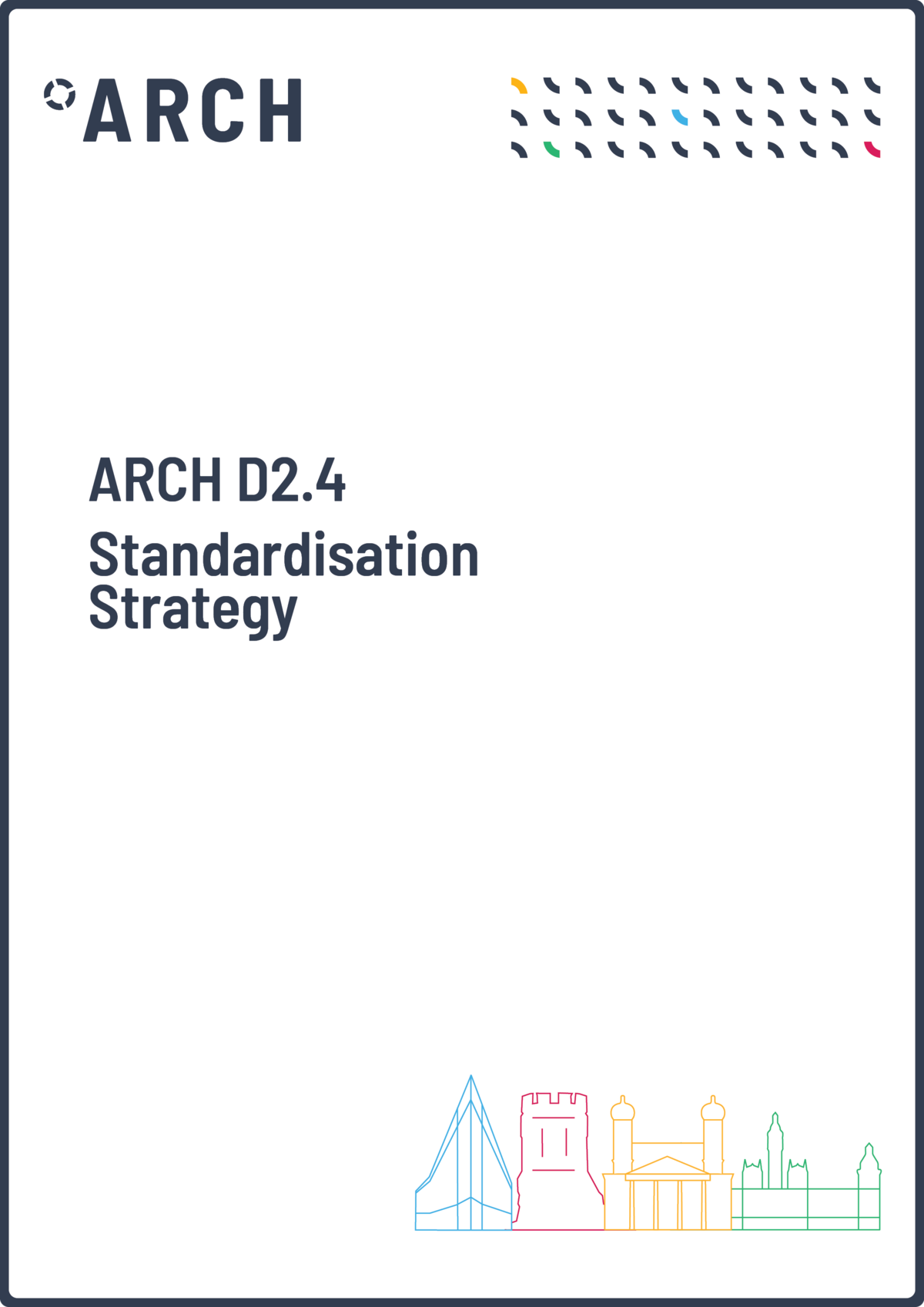
Standardisation Strategy
Deliverable 2.4, April 2022. >Download
This strategy deliverable provides an overview of the strategy for standardisation within the ARCH project, which follows a specific methodology that includes among others the identification of standardisation potentials, the initiation of new standardisation activities as well as the promotion of these standardisation activities.
The previously conducted analysis of existing standards and ongoing standardisation activities in task 7.1 (ARCH D7.1 Report 6: Existing standards and regulatory frameworks) was used together with an analysis of the external as well as internal project environment, and standardisation workshops to identify five standardisation potentials
Authors: Saskia Maresch, René Lindner (DIN)
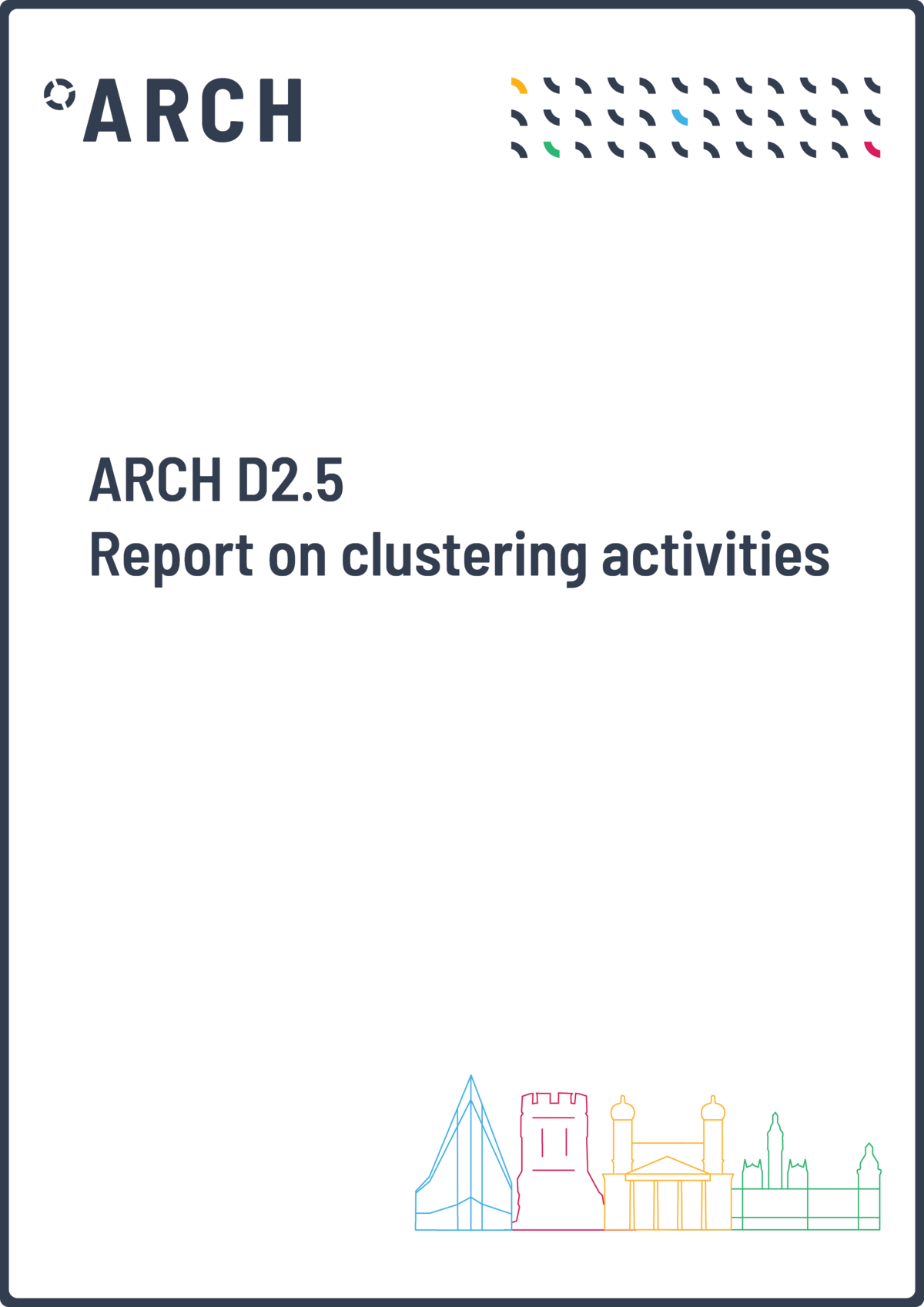
Report on Clustering Activities
Deliverable 2.5, August 2022. >Download
This report describes the activities conducted together with other topically related projects and initiatives over the runtime of ARCH. These activities include both one-off clustering activities, like joint workshop sessions, as well as longterm activities conducted within the ‘heritage cluster’, i.e., the three projects funded under call LC-CLA-04-2018.
The main outcome of the clustering activities is the founding of the EU R&I Task Force for Climate Neutral and Resilient Historic Districts in 2021, which was supported by the activities of the ‘heritage cluster’ conducted under the Horizon Results Booster. The first major outcome of the task force is a joint white paper with recommendations to overcome challenges for and make use of opportunities from resilient historic districts. This white paper is included in D2.5
as an annex.
Authors: Daniel Lückerath (Fraunhofer), Jole Lutzu (ICLEI), Katherine Peinhardt (ICLEI)
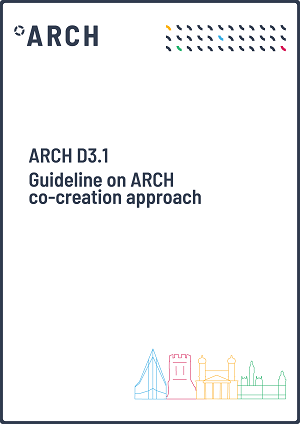
Guideline on ARCH co-creation approach
Deliverable 3.1, November 2020. >Download
The purpose of this document is to establish a harmonised methodological approach and framework for the cooperation between scientific partners and city partners within the project. More specifically, this document serves to define a common vision, principles and a practical framework (‘rules’) for working together, as well as identifying possible barriers and suggesting strategies to overcome these. It was developed drawing on literature review, but also input collected from the project team, through two workshops (held in Bratislava in June 2019 and in Brussels in November 2019), organised and facilitated by ICLEI. Revisions were made in October-November 2020, following discussion with the project team at an online meeting in September 2020.
Authors: V. Latinos, E. Chapman.
Local partnership and work plan: Bratislava, Camerino, Valencia and Hamburg
Deliverable 3.2, Updated December 2020. >Download
Each ARCH pilot city has developed a local partnership and corresponding work plan. This document presents the results of this process.
As part of this work, the four ARCH cities, supported by ICLEI, revisited the focus for their local work in connection with the project and have refined their local objectives. They identified local stakeholders who may potentially be mobilised for active engagement in connection with these objectives (and related strategies and actions) and analysed their interests and relative level of influence. This analysis has allowed the city partners to prioritise their local stakeholders, and define a core group, or ‘local partnership’. A common framework and support materials were developed by ICLEI to enable this process.
Download each city's local partnership and work plan below, or the full series here.
Chapters i-v author: E. Chapman; Co-author: I. Balenciaga.
Local partnership and work plan – Bratislava
Author: E. Streberová; Co-authors: A. Gondová, M. Musilova, E. Pauditšová, S. Brnkaľáková. >Download
Local partnership and work plan – Camerino
Authors: M. Iommi, Q. Piattoni. >Download
Local partnership and work plan – Hamburg
Authors: U. K. Mense, B. Paulowitz, J. Leenen; Co-author: E. Chapman. >Download
Local partnership and work plan – Valencia
Authors: E. Servera, L. Garcia. >Download
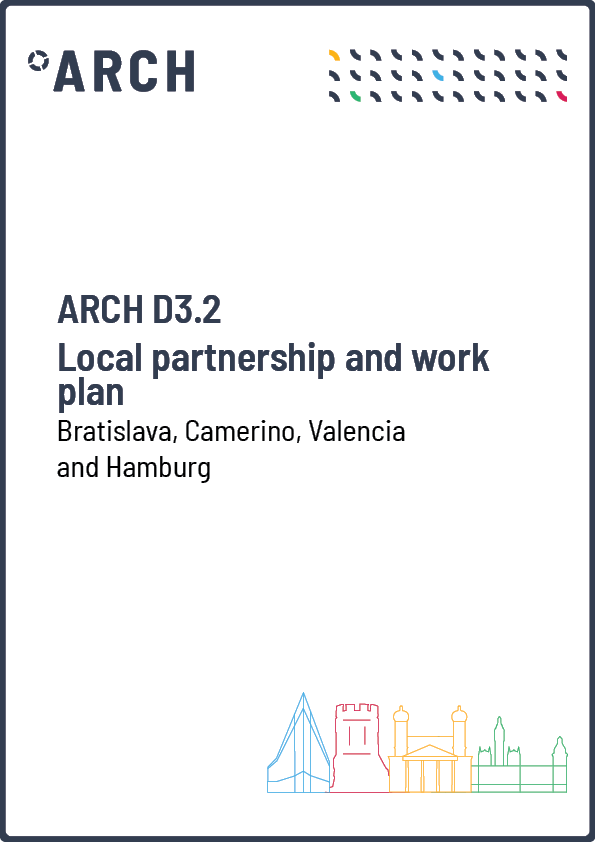
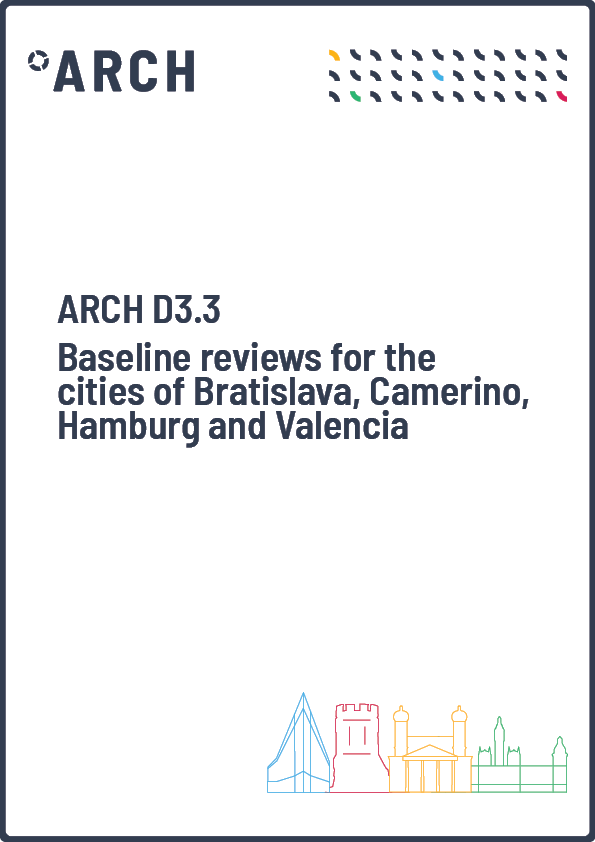
City baseline report
Deliverable 3.3, December 2021. >Download
This report establishes the baseline for the municipalities of Bratislava, Camerino, Hamburg and Valencia, with respect to their selected cultural heritage sites. The ARCH project has a multi-dimensional thematic focus on 1) cultural heritage management, 2) disaster risk reduction and 3) adaptation to climate change, and as such all three dimensions are addressed in each city’s baseline review. The primary aim of this report is to introduce the scientific partners to the pilot cities, and specifically to their selected cultural heritage sites for further analysis in the context of ARCH. A secondary aim is, through the writing process, to equip the city partners (as lead authors) with expanded knowledge of the governance frameworks relevant to all three thematic areas mentioned. Download each city report below, or the full series here.
City baseline report – Bratislava
Author: E. Streberova; Co-authors: S. Klacanova, M. Steflovicova, M. Musilova, E. Pauditsova, S. Hanania, D. Lückerath, K. Milde, S. Giovinazzi, L. Giordano. >Download
City baseline report – Camerino
Authors: M. Iommi, Q. Piattoni, S. Giovinazzi; Co-authors: A. Dall’Asta, M. Morici, S. Hanania, J. Lutzu, D. Lückerath, K. Milde. >Download
City baseline report – Hamburg
Author: Uta K. Mense; Co-authors: B. Paulowitz, E. Chapman, M. von Mach, D. Lückerath, K. Milde, E. Rome, S. Giovinazzi, L. Giordano. >Download
City baseline report – Valencia
Authors: L. García, G. Roig, E. Servera, S. Zorita; Co-authors: E. Chapman, J. Lutzu, D. Lückerath, K. Nickel, O. Ulrich, S. Giovinazzi, L. Giordano. >Download
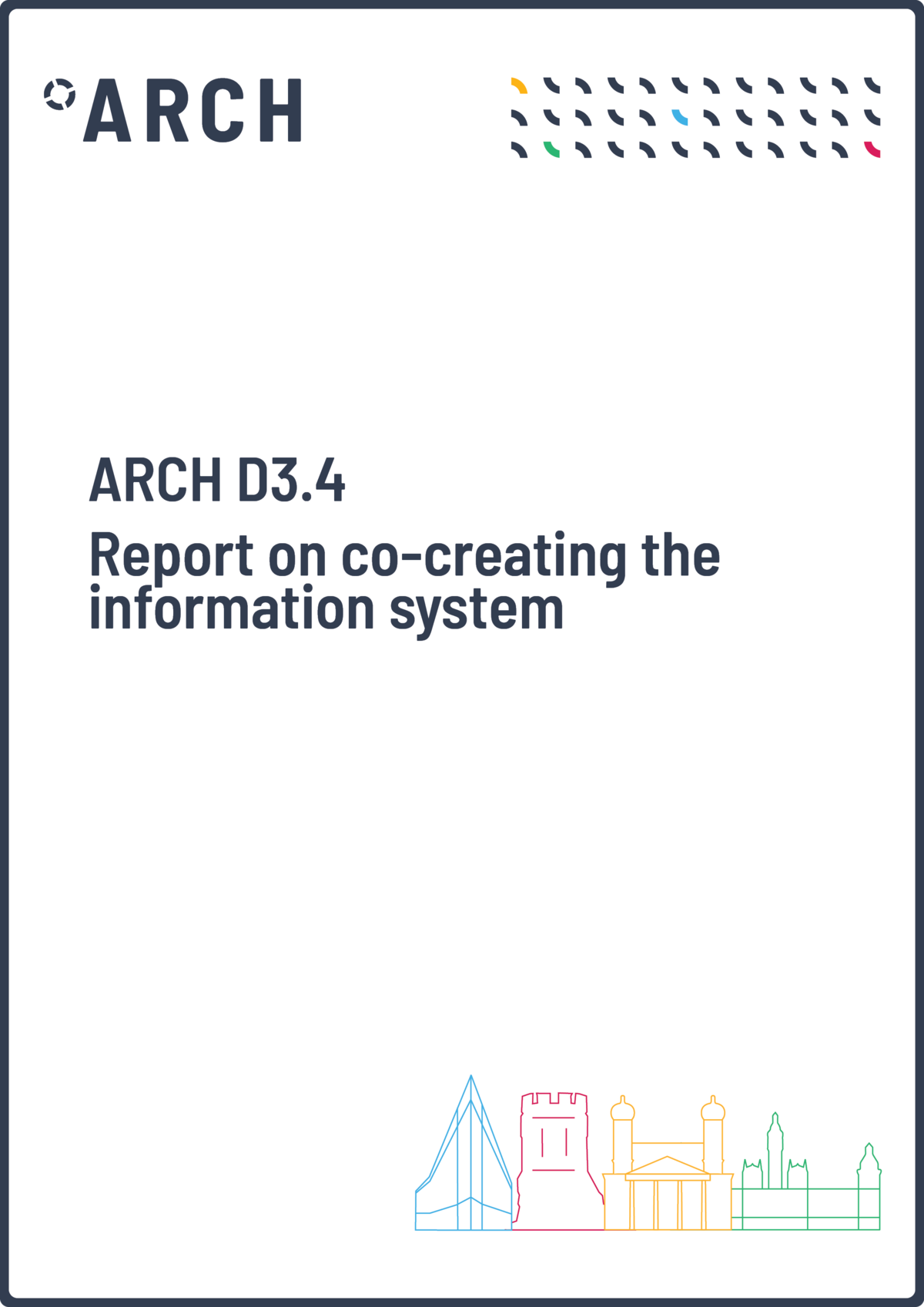
Report on co-creating the information system
Deliverable 3.4, March 2022. >Download
This deliverable describes the process of co-creation specifically related to the development of the information systems, as already reported in previously released deliverables (i.e. the Historic Area information system - HArIS in Deliverable 4.2 and Threats and Hazard information system - THIS in Deliverable 4.3), as well as that for implementing the analysis services and developing instrumentations (which are described in the Deliverable 4.1).
More specifically, the document outlines the specific meetings and local workshops organised to exchange information with the four pilot cities of ARCH, describes how these workshops were conducted, which partners and stakeholders were involved, which results were gathered, how the results were addressed, and which lessons were learned as a result of the process.

Report on co-creating the ARCH HUB and ARCH RAD
Deliverable 3.6, June 2022. Revised 2023. >Download
This deliverable describes the co-creation process for developing the ARCH HUB and ARCH Resilience Assessment Dashboard (RAD), which collectively constitute the ‘ARCH management platform’ (also called ‘ARCH data and information platform’).
The ARCH RAD provides an online self-assessment for decision makers in heritage management, disaster risk management, climate change adaptation, and resilience at regional, municipal, and historic area level, to collaboratively evaluate and monitor the resilience maturity of a historic area according to the ARCH Resilience Framework described in D7.3, it allows these end-users to identify resilience weak spots, and supports the formulation of resilience action plans. The ARCH HUB provides a resilience knowledge base that gives end-users detailed information on how to apply the ARCH Resilience Framework, gives access to best practices in resilience building (as provided in D7.2 [2]), and provides a directory of tools, methods, handbooks, and other helpful resources for resilience building (from ARCH and beyond), linked to the steps of the ARCH Resilience Framework as well as the different topics covered by the RAD.
Authors: Katharina Milde, Valerie Wischott, Daniel Lückerath
(Fraunhofer)
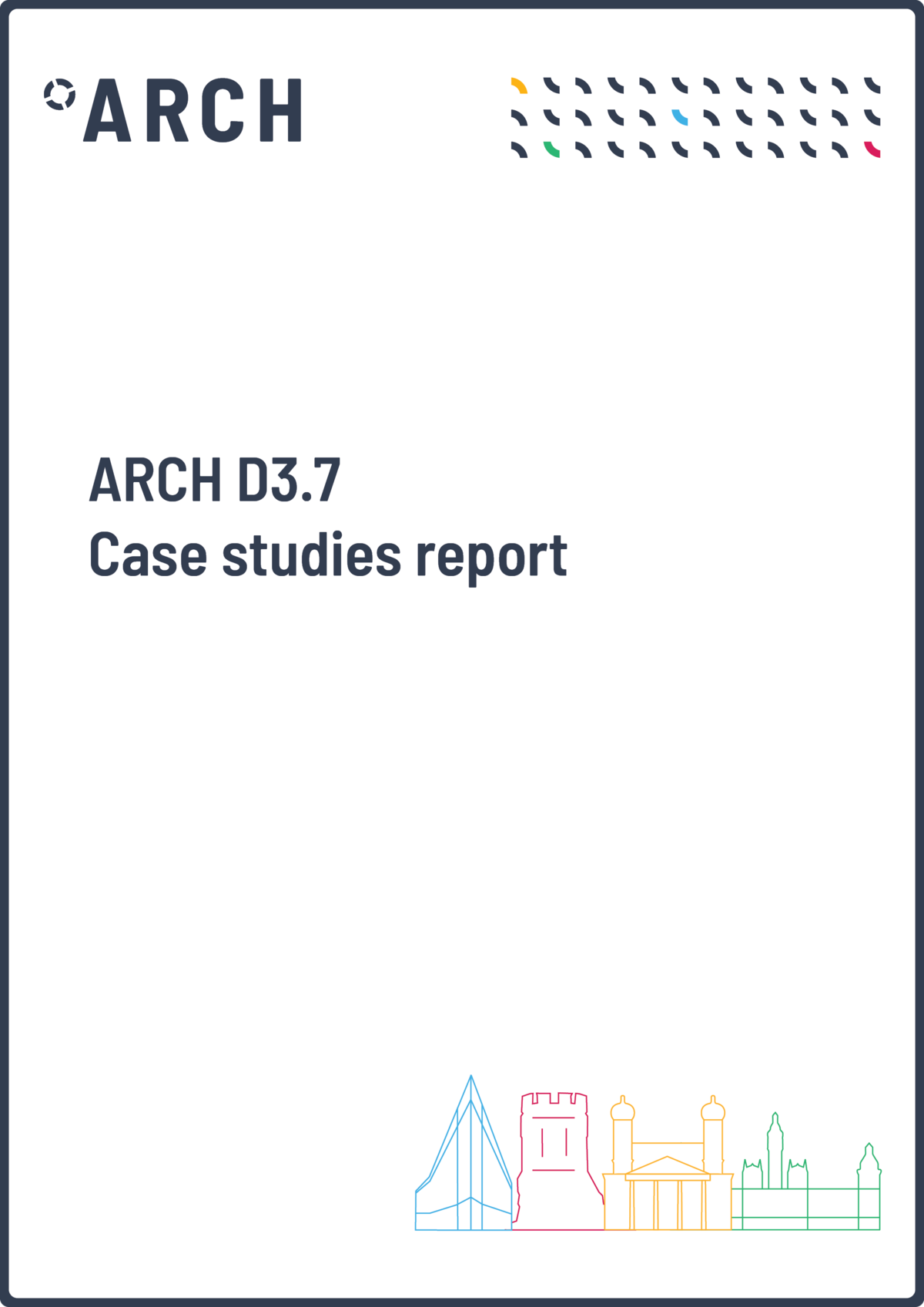
Case studies report - Experiences and lessons learnt
Deliverable 3.7, August 2022. Revised 2023. >Download
The project team has developed seven tools to help cities protect areas of cultural heritage
from hazards and risks. These were co-created with the foundation cities to test them and
produce practical results that can be applied in the cities.
To understand and learn from the cities´ experiences, this report includes the different activities
and conclusions that can be drawn from them. It reflects on the project activities with the four
foundation and the twelve keystone cities.
Overall, the ARCH project showed that co-creation activities involving city partners and if
possible, local stakeholders within a project is crucial to produce results that are of use and
tested along their development which makes it also more effectively than to adjust the results
after their finalisation.
Authors: Maria von Mach (ICLEI), Daniel Lückerath, Valerie Wischott, Katharina Milde (Fraunhofer)
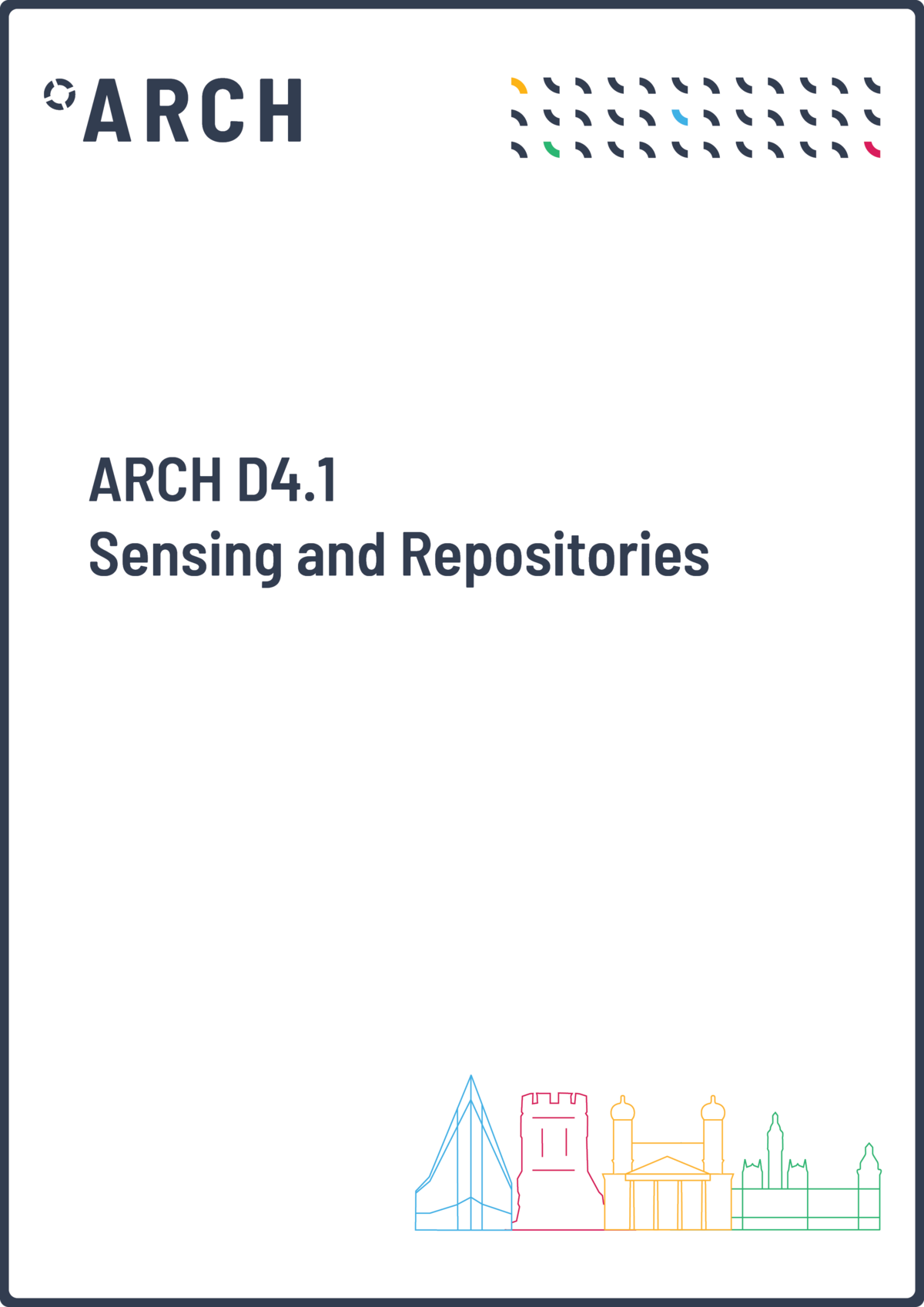
Sensing and Repositories
Deliverable 4.1, July 2021. >Download
This deliverable is the key output of task 4.1 “Sensing and Data Repositories” within work package 4 “Hazard & Object Information Management System”. The aim of Task 4.1 was the development and application of technological means for determining the current condition of heritage assets and for the characterization of historic areas. This document outlines the research and development concepts related to task 4.1, together comprising the overall repository of sensor data about heritage assets and their environmental conditions, ready for passing its data on the historic areas and hazards to the information management systems.
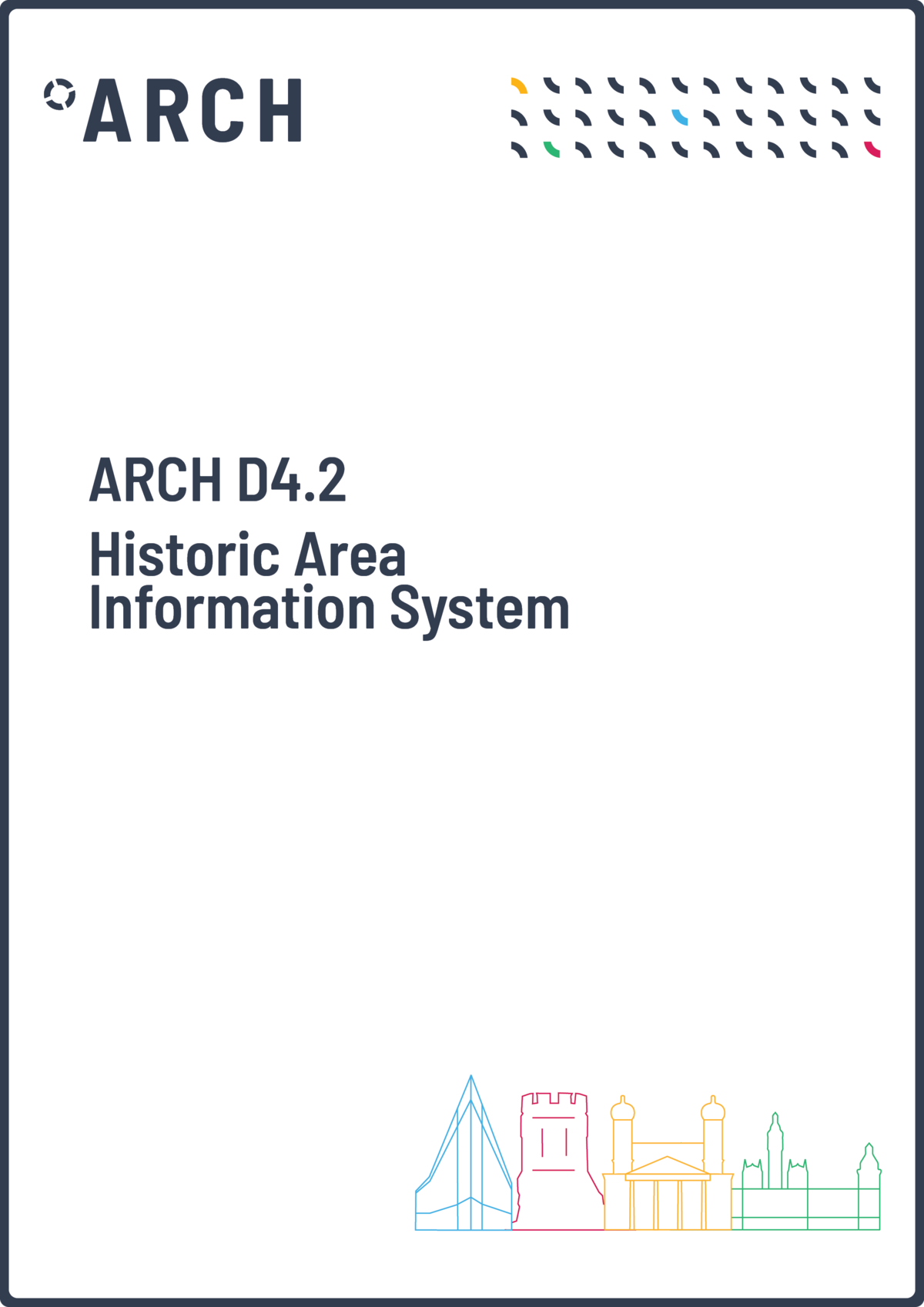
Historic Area Information System
Deliverable 4.2, July 2021. >Download
The aim of Task 4.2 was the development of the systems and tools to structure, query and analyse data related to the historic area and the elements it contains. By considering historic areas as complex Social-Economic Systems, the different domains of these systems have been analysed, focusing the attention not only on the historic area itself, but also on the larger system in which it is included. The georeferenced information has been selected and structured in the Historic Area Information System with reference to the built and natural environment, the cultural heritage elements, and the social-economic context. Data and information to characterize the heritage assets and to assess their state are provided to support the subsequent vulnerability analyses (WP5), also taking into account that these indicators depend on the potential hazards. In addition, a specific relational database has been developed to store information at building\object scale about the heritage assets and to relate information to each other.
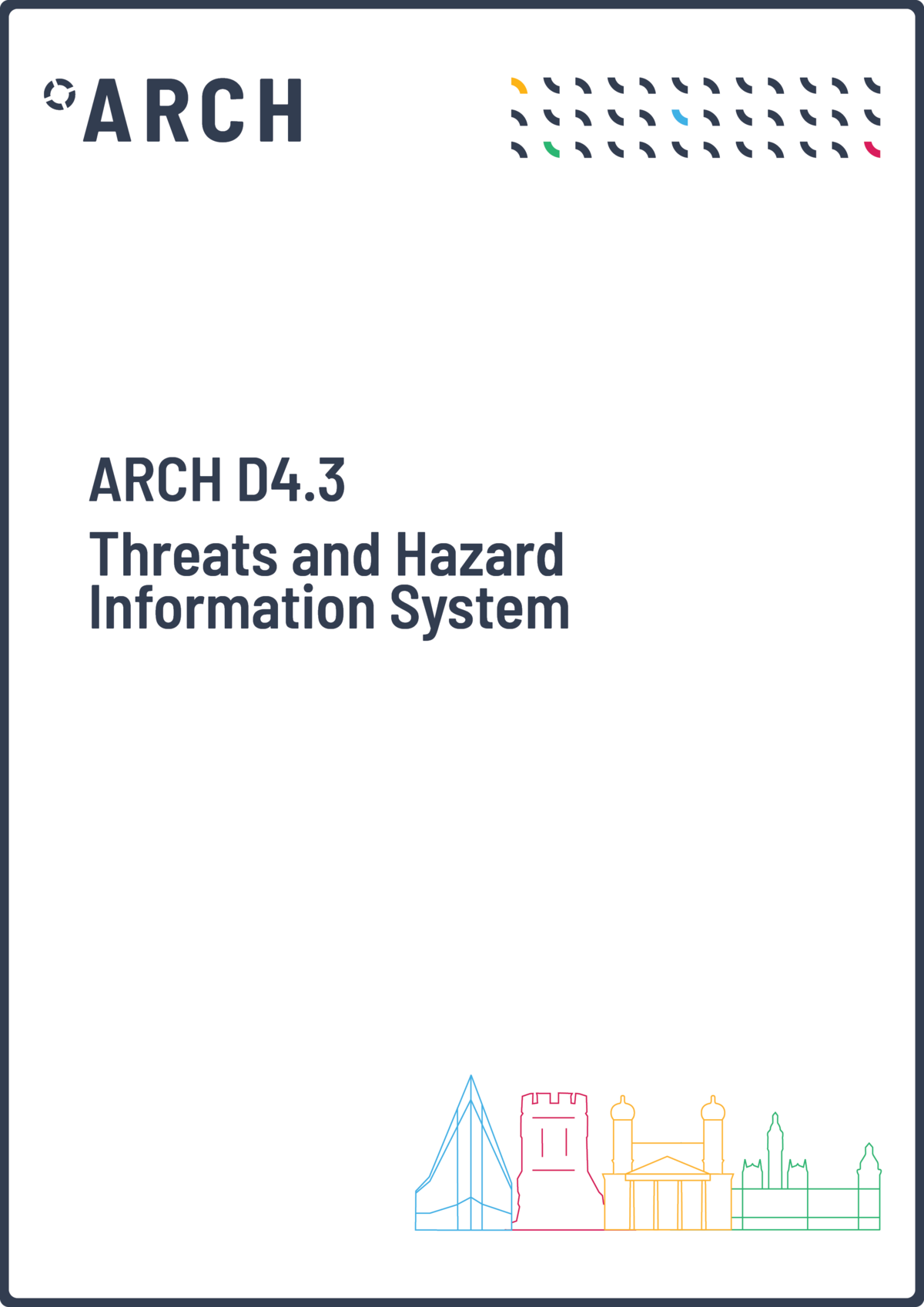
Threats and Hazard Information System
Deliverable 4.3, October 2021. >Download
The match-making online meetings and co-creation processes (led by ICLEI) involving cities, stakeholders and technical partners, allowed to identify the main environmental threats and hazards, as well as to select measurable indicators for their characterisation. However, considering that the historic areas in ARCH are exposed to different threats, specific analyses and tools were required for each case study, and only some datasets were collected in the same way for all cities. To this end, ad-hoc services and database were developed to manage historical datasets, real-time measures from monitoring systems and projections for the future. The indicators obtained from the data-processing are provided to support the subsequent risk analysis and impact scenarios, as well as to inform cities and their stakeholders. The work described in this deliverable focused on:
- the implementation of an earthquake monitoring service to notify as soon as a new earthquake occurs in the European area, by querying the official catalogues, and to process the recordings coming from the Real-Time Urban Seismic Network deployed in (and around) the historic centre of Camerino (Italy);
- the development of the database to structure: (1) environmental measurements from crowd-sensing and official monitoring system, in order to inform about the climatic conditions and air quality in near real-time, and (2) available time-series relating to different categories of indicators, which were calculated on the base of local measures, to characterise the weather and climate extremes in the past;
- the development of a sub-system for mapping environmental contaminations considering their potential spatial and temporal evolution;
- the development of ad-hoc climate services, by processing of datasets available from existing services, to elaborate specific projections of the most relevant indicators characterising the threats and the potential effects related to the climate-change.
Finally, the main information are made accessible through the GIS dashboards of the Threats and Hazard Information System (THIS), which together with the tools of the Historic Area Information System (HArIS), are implemented in the web-platform of the ARCH information systems reachable through the ARCH-Hub.
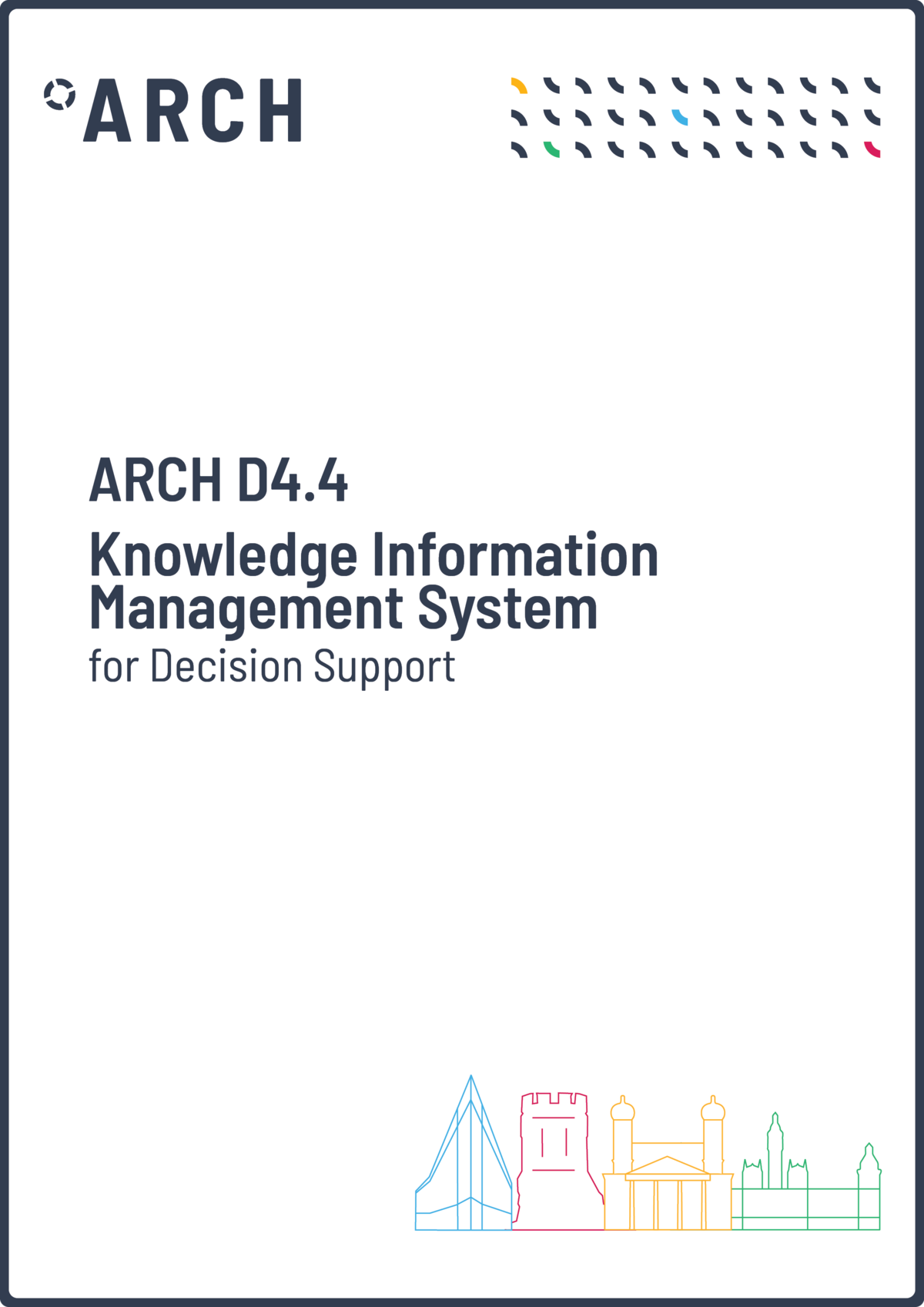
Knowledge Information Management System for Decision Support
Deliverable 4.4, December 2021. >Download
The large amount of data needed for assessing and managing disaster resilience in historic areas, and the multiple interconnections between tangible and intangibles entities and services provided by historic areas, brought the ARCH project to face and overcome the complexity of defining a conceptual data model aggregating data retrieved by distinct databases to generate meaningful information and of processing information to generate knowledge.
This deliverable summarizes methods, data and results obtained by the ARCH project to generate relevant information and knowledge to support decision making process related to the resilience of historic areas to climate change and other hazards.
In particular the deliverable reports on:
- The established interoperability between the ARCH Information System and the ARCH Decision Support System (DSS) for the exchange of information
- The great potentialities in terms of knowledge management and knowledge generation that might arise from:
- the implementation of ontology-based and semantic-based spatiotemporal assessment towards enhancing the awareness and the capacity building on disaster resilience at historic area-level;
- automated approaches for 3D modelling and the automatic crack/damage detection based on deep learning towards the preventive conservation of cultural heritage buildings.
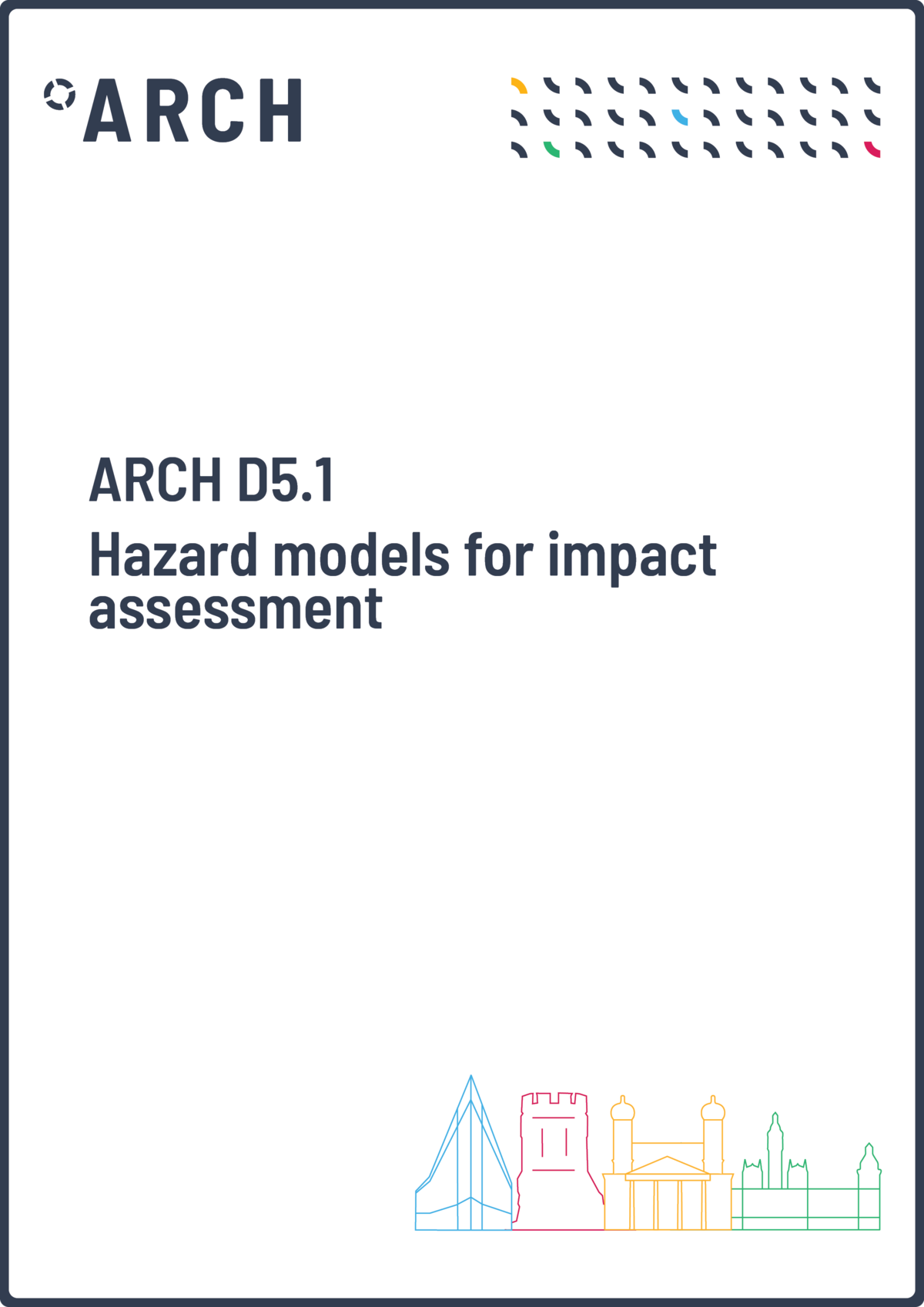
Hazard models for impact assessment
Deliverable 5.1, November 2021. >Download
The aim of Task 5.1 has been to develop and adapt hazard models and to foresee the use of further environmental and heritage asset data collected as part of WP4 “Hazard & Object Information Management System” to be used for estimating the possible impacts on Historic Areas due to climate change and other hazards such as earthquakes.
Toward that, hazard models described in this deliverable, as well as hazard indicators defined in WP4, will be coupled with the vulnerability models, described in Task 5.2 Vulnerability and consequence analysis, aiming to assess risk and impacts scenarios, co-created with the 4 ARCH pilots (as described in Task 3.4.3) and implemented and represented within ARCH Decision Support System, DSS (T5.3).
The work describes in this deliverable focused in particular on summarizing methods, data and results in relation to:
- Climate-change hazard maps for
- extreme temperature assessed under different climate scenarios according to the current land use and under the hypothesis of possible future modifications of the land use;
- pluvial flooding accounting for, digital terrain models, and urban parameters (such as building height, land cover, vegetation).
- Earthquake hazard maps for
- ground motion shaking produced for both user-defined and real earthquake events;
- soil characterization to support the identification of resonance effects and possible soil-structure interactions;
- earthquake-induced mass movements and landslides.
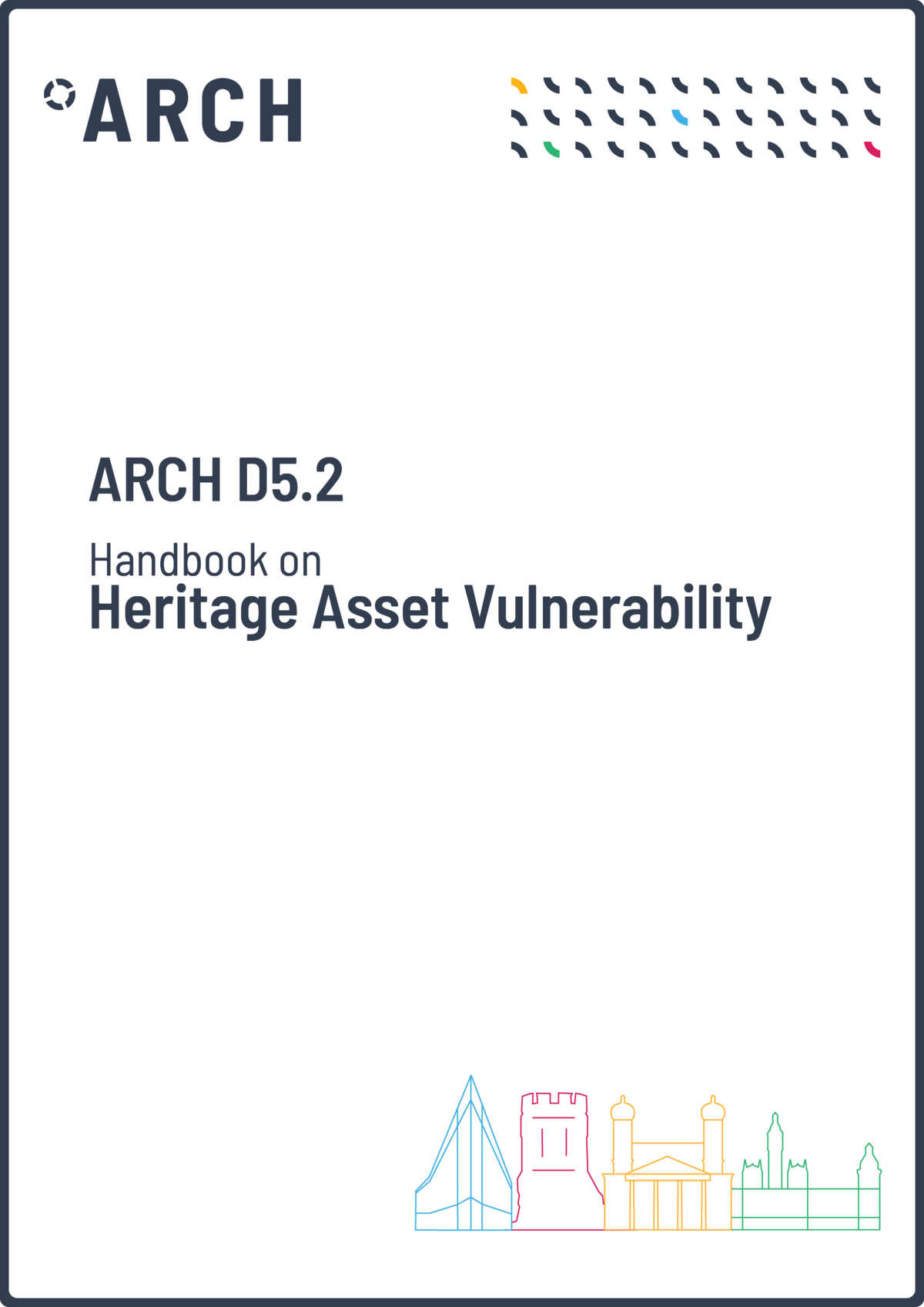
Handbook on Heritage Asset Vulnerability
Deliverable 5.2, December 2021. >Download
The aim of task 5.2 is to develop and adapt models and methods to assess the vulnerability of historic areas and to estimate potential consequences, based on the hazard models from T5.1 and the data about the current condition of heritage assets from T4.4. This has been performed by defining state indices for heritage assets (e.g. material degradation, structural capacity, soilfoundation capacity, population density, education levels, age and gender distribution, etc.) and quality parameters for measuring service degradation. Damage functions are developed and adapted to quantify different consequences deriving from a variation of the asset state and hazard characteristics (e.g. intensity). Subsequently, the relationships (damage functions) between hazards (stresses or shocks) and state indices variations are defined by combining information from literature and data collected during the co-creation activities (WP3). The main objective of this action consists in calibrating damage functions coherently with the information detail available. The proposed damage functions will be validated based on historical data recorded during previous disasters.
The definitions of state indices, quality parameters and damage functions provide a contribution for the design of the monitoring actions and the work are carried out in connection with relevant monitoring activities of WP4.
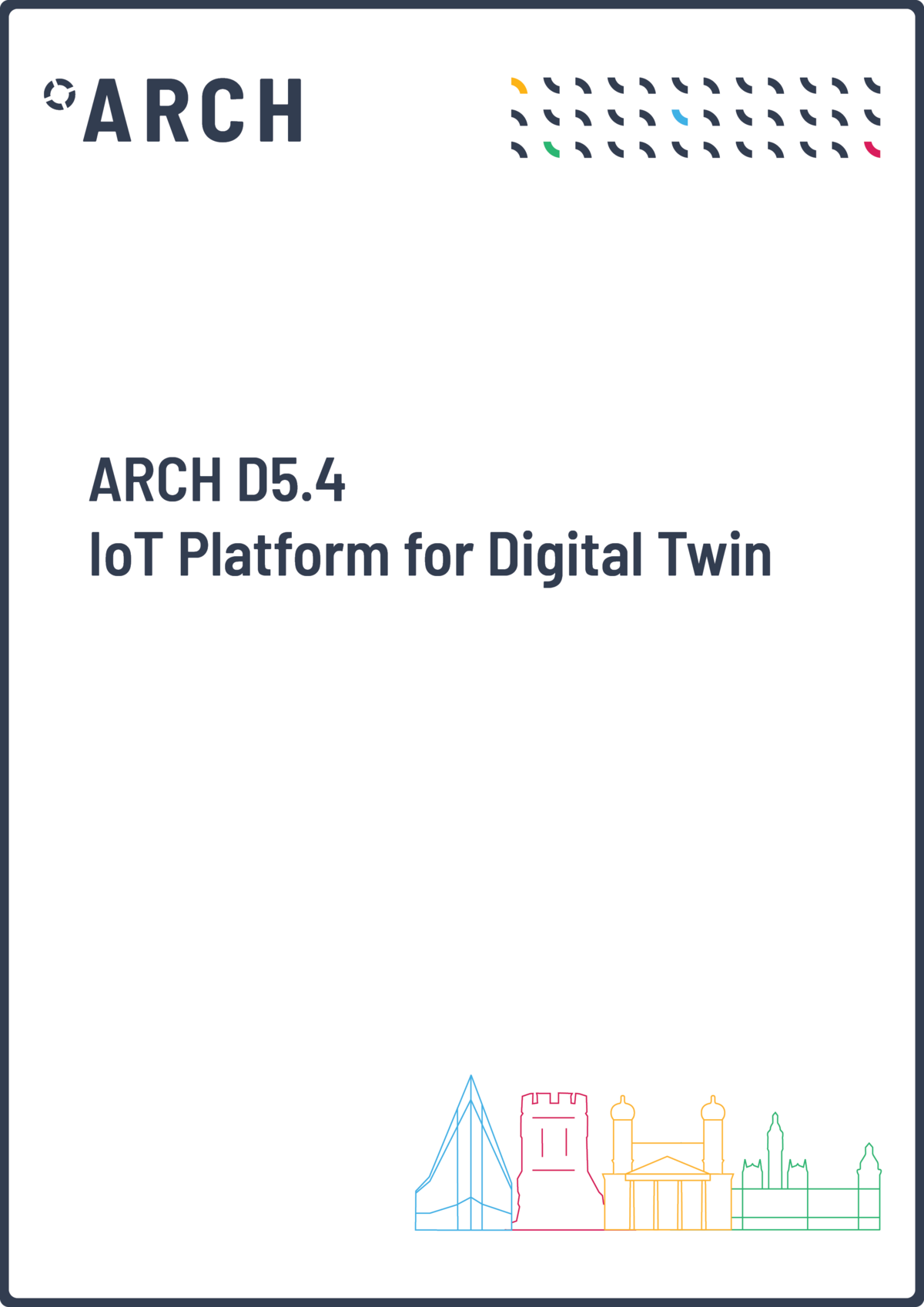
IoT Platform for Digital Twin
Deliverable 5.4, March 2022. >Download
This report reflects work to create an Internet of Things (IoT) platform to gather relevant realtime data from heritage assets (temperature, humidity, crack width, vibration, etc.) for impact and risk assessment. The D5.4 report, IoT Platform for Digital Twin, describes the architecture of the IoT Platform, how to deliver IoT sensing data to the management system, and the protocol and data format of captured data.
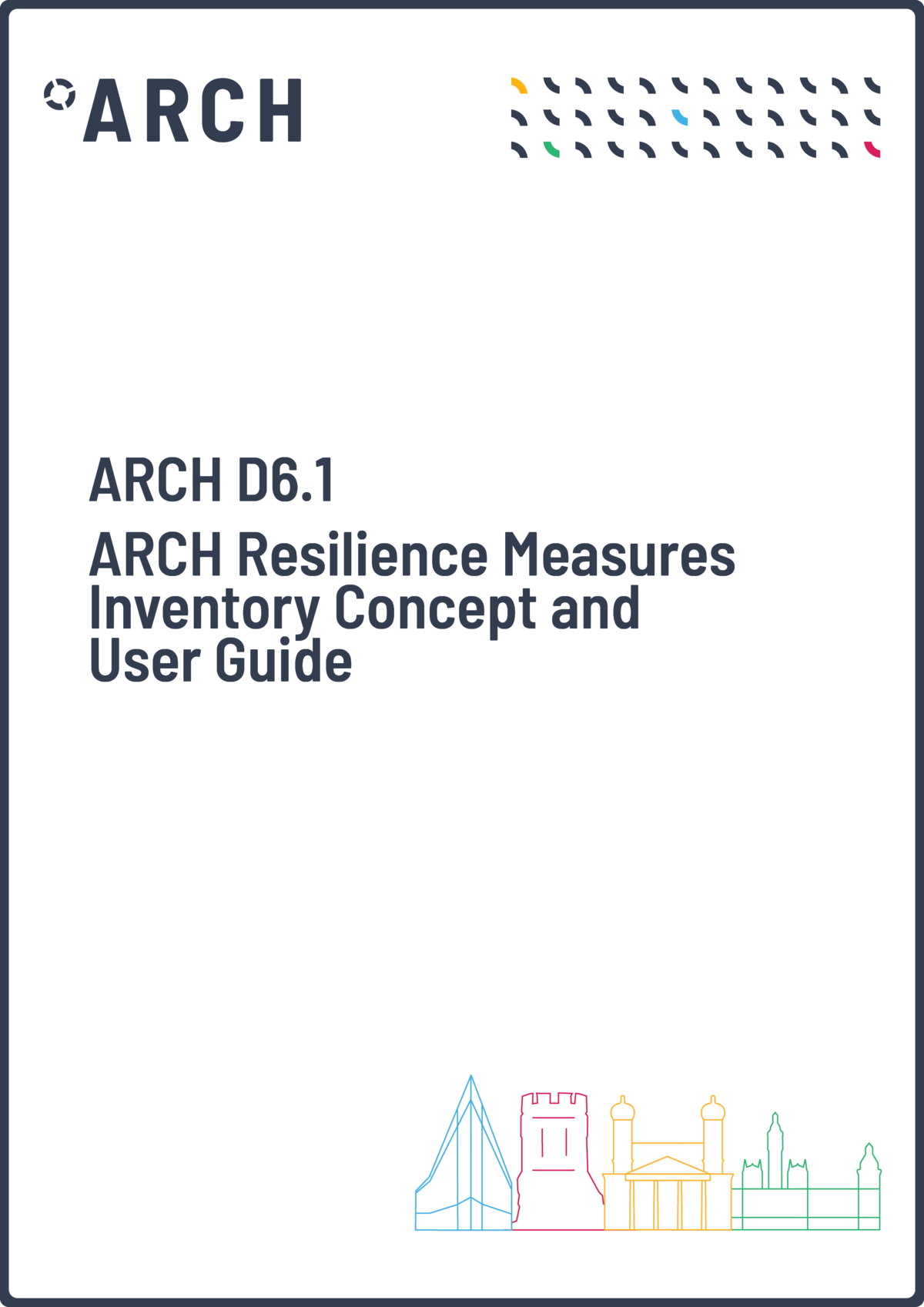
ARCH Resilience Measures Inventory - Concept and User Guide
Deliverable 6.1, May 2021. >Download
This report, “D6.1 ARCH Resilience Measures Inventory: Concept and user guide” is a supporting document to the key output of the task, the ARCH Resilience Measures Inventory (RMI). It is a practical deliverable that is conceived to describe the content and structure of the RMI to support its use and navigation. The RMI is conceptualised to support municipalities and relevant stakeholders to identify suitable resilience measures for historic areas as a way to protect European cultural heritage and socio-ecological systems. The focus of the inventory is twofold: 1) built heritage as well as 2) cultural landscapes, with focus on agricultural heritage. The RMI is an inventory of suitable resilience measures for Historic Areas, gathered from good practices, literature review and stakeholders’ inputs which provides a general description as well as a general assessment of the implementation of these measures. It uses Microsoft’s software Power BI, a tool for visualising data and analytics reporting tool format, which is easy to use and makes it possible to explore, identify, and assess features of the resilience measures such as visual, physical or spatial impacts of the solutions as well as their cobenefits.
Concept Note and Guidance >Download
User Guide >Download
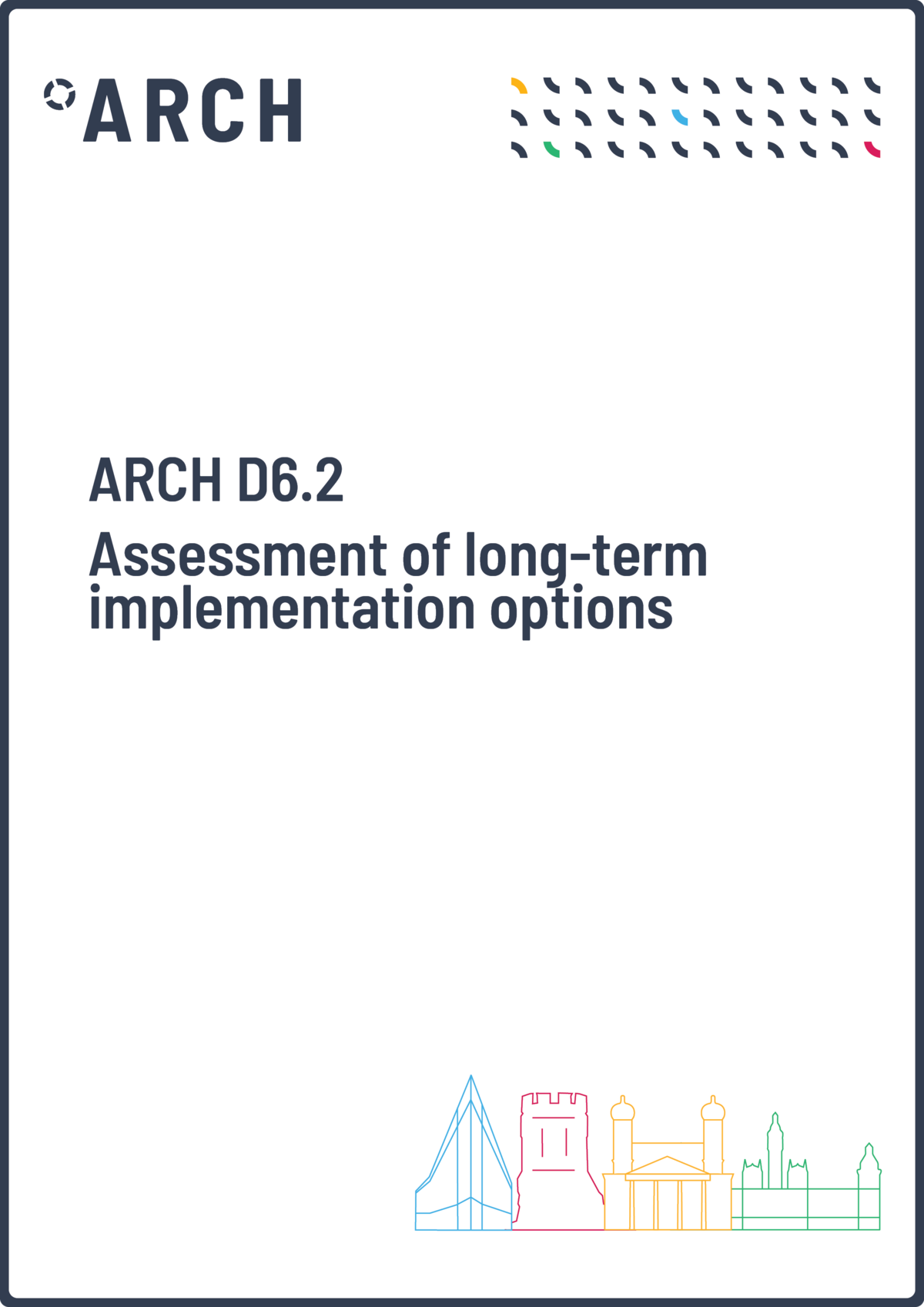
Assessment of long-term implementation options
Deliverable 6.2, March 2022. >Download
The aim of task 6.2 is to assess the longterm performance of resilience measures identified in T6.1 around three main spheres of knowledge: environmental effectiveness, economic efficiency, and socio-institutional acceptance. At the same time, the outputs of task 6.2 are inputs for task 6.4.2 Developing a resilience pathway visualization tool.
Authors: Angela Matesanz Parellada, Olatz Nicolás Buxen, Nieves Peña Cerezo, Amaia Sopelana Gato, Elena Turienzo López, Saioa Zorita Castresana (Tecnalia); Livio Pedone, Cristina Rosca, Sonia Giovinazzi (ENEA); Michele Morici, Andrea Dall’Asta, Lucia Barchetta (UNICAM)
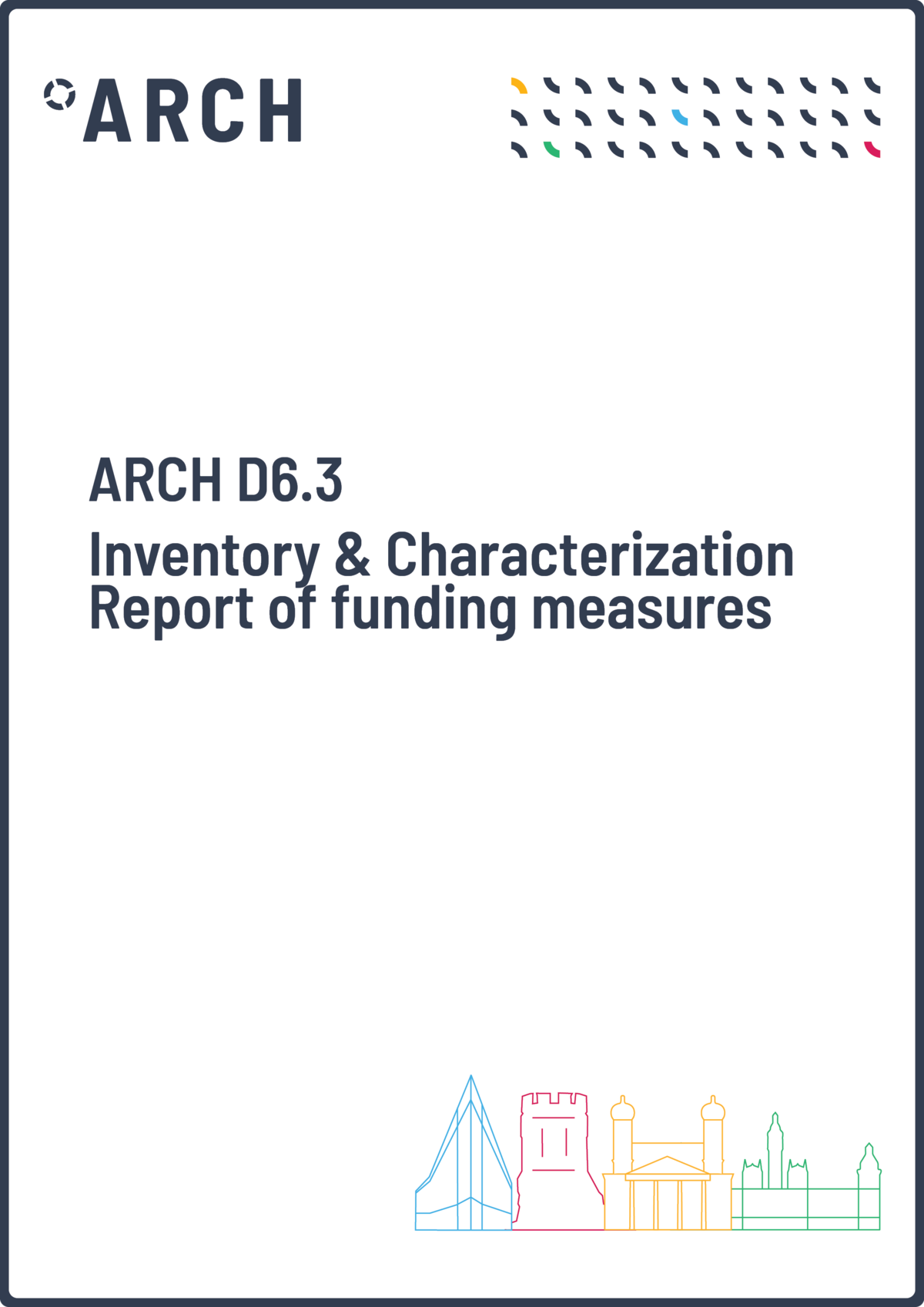
Inventory & Characterization Report of funding measures
Deliverable 6.3, May 2022. >Download
This deliverable comprises an inventory of funding measures available from the
public and private sectors and also from some of the most important financial and public institutions at the European and national levels. D6.3 is part of WP6 “Resilience Options and Pathway”, which gives insights into how to select the best available resilience options to prepare historic areas and their nature-based resources against potential damages, complementing these insights with the most appropriate funding measures.
Authors: Laura Bano, Rose Ortolani, Marco Devetta (SOGESCA)
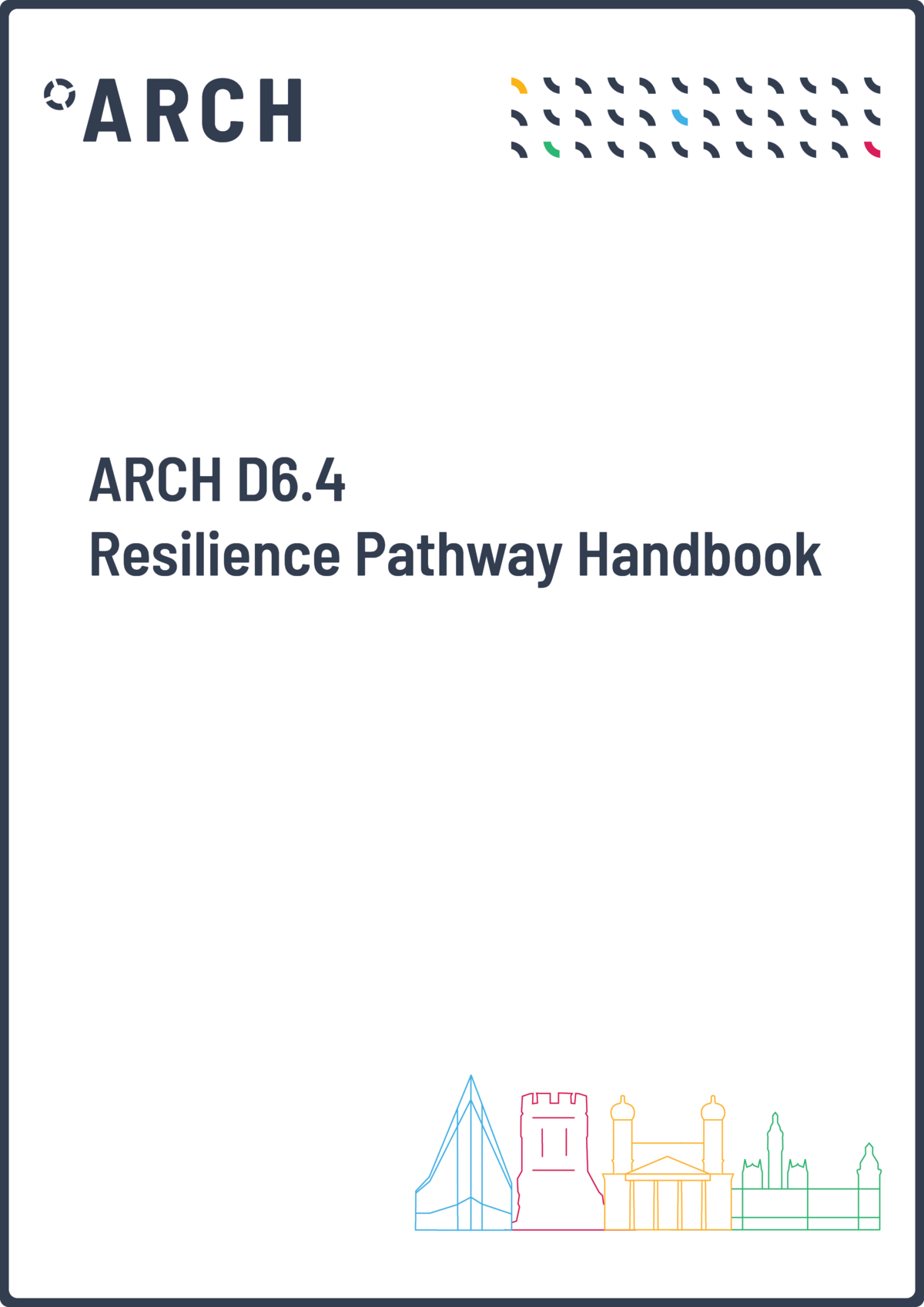
Resilience Pathway Handbook
Deliverable 6.4, September 2022. Revised 2023. >Download
ARCH has produced a Resilience Pathway Visualization Tool (RPVT), a web-based tool to assist on the graphical display of pathways. The Resilience Pathway Handbook has been developed to guide in the pathway approach, and introduce concepts and steps, since this approach is a novel methodology to support planning.
Author: Saioa Zorita (Tecnalia)
Co-authors: Laura Bano, Rose Ortolani (SOGESCA); Nieves Peña (Tecnalia)
State-of-the-art reports of concepts, approaches, standards and technologies
Deliverable 7.1, November 2019. >Download
In this series of six reports, concepts, approaches, standards and technologies relevant to the scope of the ARCH project were reviewed and analysed. These reports provide the project team with a shared understanding of key framework conditions relevant to the project. The content will contribute to an ARCH project glossary, serve as a basis for the development of a disaster risk management framework for historic areas and an inventory of measures to support all three stages of the disaster risk management cycle, and inform future standardisation activities. Download each report below, or the full series here.
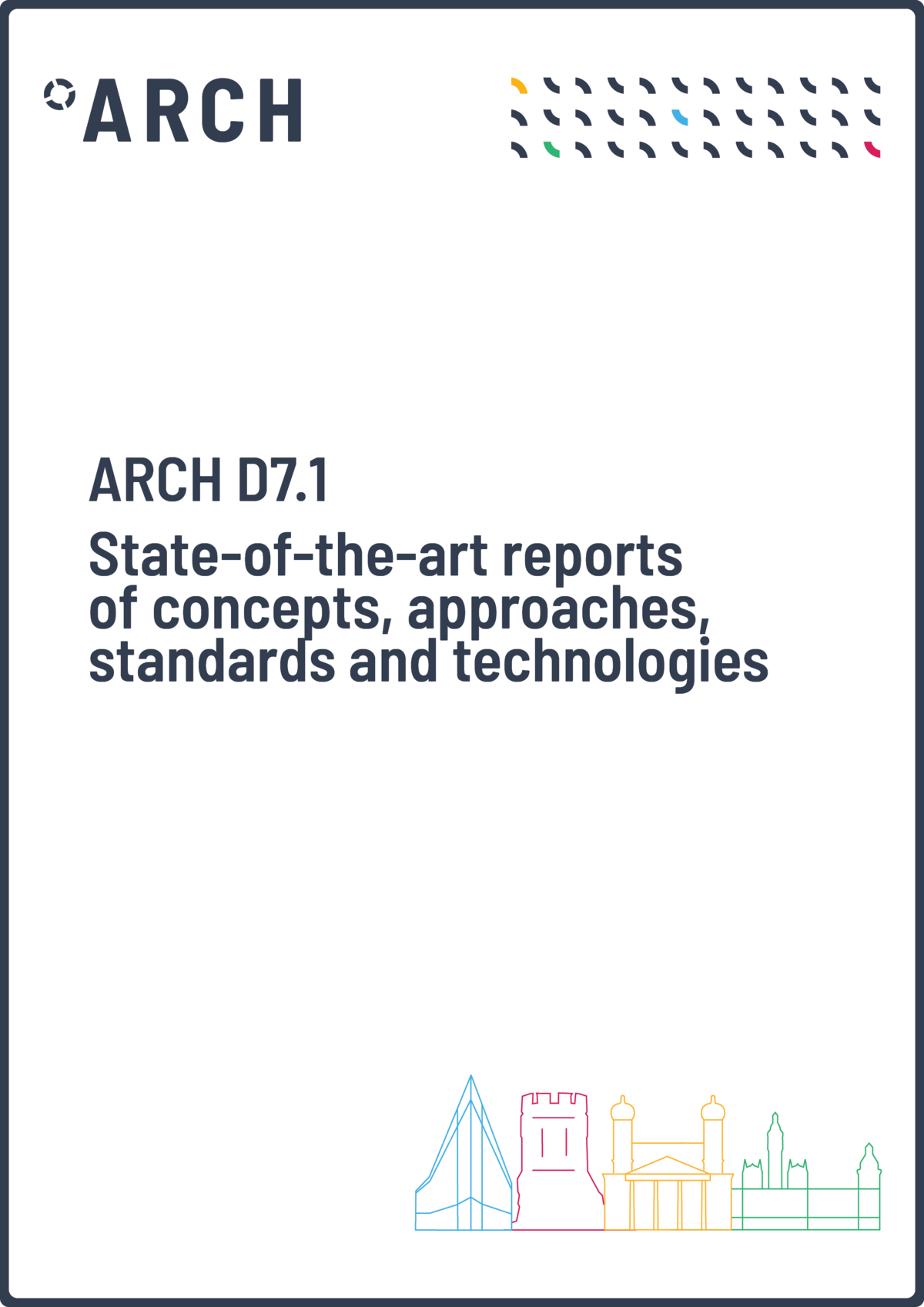
7.1 Report 1: Historic areas, conservation practices, and relevant regulations/policies
Deliverable 7.1, November 2019.
Authors: A. Gondová, M. Musilova; Co-Author: M. Zubiaga. >Download
Identification and review of relevant definitions, practices, regulations, and policies related to the management and conservation of heritage assets.

7.1 Report 2: Disaster risk management, emergency protocols, and post-disaster response
Deliverable 7.1, November 2019.
Authors: M. Mendizabal, S. Zorita, M. Musacchio, A. Costanzo. >Download
Identification and review of existing disaster management policies / frameworks, emergency protocols, as well as post-disaster response techniques and identification ofgaps with regard to the integration of heritage assets.

7.1 Report 3: Building back better
Deliverable 7.1, November 2019.
Author: D. Lückerath, M. I. Pannaccione Apa >Download
Identification and review of existing policies/frameworks and technologies to enable implementing the principle of building back better.

7.1 Report 4: Decision support frameworks and technologies
Deliverable 7.1, November 2019.
Authors: E. Rome, K. Milde, O. Ullrich; Co-Author: A. Krukowski >Download
Identification and review of existing frameworks and technologies for decision-making processes and support systems, both generic as well as related to heritage conservation and climate change adaptation.

7.1 Report 5:Gender aspects in conservation and regulation of historic areas, disaster risk management, emergency protocols, post-disaster response techniques, and techniques for building back better
Deliverable 7.1, November 2019.
Authors: V. Rebollo, T. Rangil-Escribano, E. Chapman >Download
Identification and review of existing policies/frameworks and technologies to enable implementing the principle of building back better.

7.1 Report 6: Existing standards and regulatory frameworks
Deliverable 7.1, November 2019.
Author: A. Schäfer, S. Maresch; Co-Author: V. Latinos >Download
Analysis of both existing standards and ongoing standardisation activities in the field of resilient cities, heritage assets, and the given keywords will be performedand overview and assessment of existing formal and informal standards on National, European, and International level (CEN, ISO etc.) as well as regulatory frameworks.

Combined Glossary of Definitions and Terms for ARCH
Deliverable 7.1, November 2019.
Editor: D. Lückerath >Download
This appendix contains the currently used definitions for ARCH plus all definitions provided in the six SotA reports. This extended set of definitions and terms constitutes the ARCH project glossary. It will also be provided as a separate stand-alone living document, to be extended and updated whenever necessary during the execution of the project.


Good Practices in Building Cultural Heritage Resilience
Deliverable 7.2, November 2020. >Download
This report is meant to serve as an inventory of good practices in building cultural heritage resilience. It contains an overview and classification of 40 cultural heritage resilience initiatives, providing information on their location, biogeographical region and lead(s). 32 of them are featured as snapshots and eight of them as case studies (containing in-depth information on aspects such as main outcomes, factors of success and lessons learned). Additionally and reflecting upon the term “replicability”, the report proposes a set of criteria to evaluate their transferability potential to other urban contexts.
Authors: V. Rebollo, V. Latinos. Co-authors: I. Balenciaga, R. Roca.
ARCH Disaster Risk Management Framework
Deliverable 7.3, November 2020. >Download
This deliverable has been prepared for the European Commission-funded research project ARCH: Advancing Resilience of historic areas against Climate-related and other Hazards. It is the key output of task 7.3 “ARCH disaster risk management framework” within work package 7 “Framework & Integration”. The aim of task 7.3 is twofold: (1) to develop a combined disaster risk management (DRM) / climate change adaptation (CCA) process specifically aimed at historic areas that helps heritage managers, public administrators, and other actors in the field of DRM and CCA to understand which steps are necessary to develop a combined DRM / CCA plan that helps to improve the resilience of historic areas; and (2) to provide a conceptual structure for the solutions developed by the different work packages of the project and indicate where these can support end-users in the combined DRM / CCA process. To achieve this, a review of existing DRM and CCA frameworks was conducted to identify best practices and gaps, with special focus on heritage management. In parallel, a co-creation process with project partners was established to receive early feedback and ensure practicality for endusers as well as compatibility with other project solutions. This report describes the result from these processes
Authors: Katharina Milde, Daniel Lückerath, Oliver Ullrich
Contributors: Eleanor Chapman, Cristina Garzillo, Saioa Zorita, Anna Gondová , Saskia Maresch, Sonia Giovinazzi, Manfred Bogen
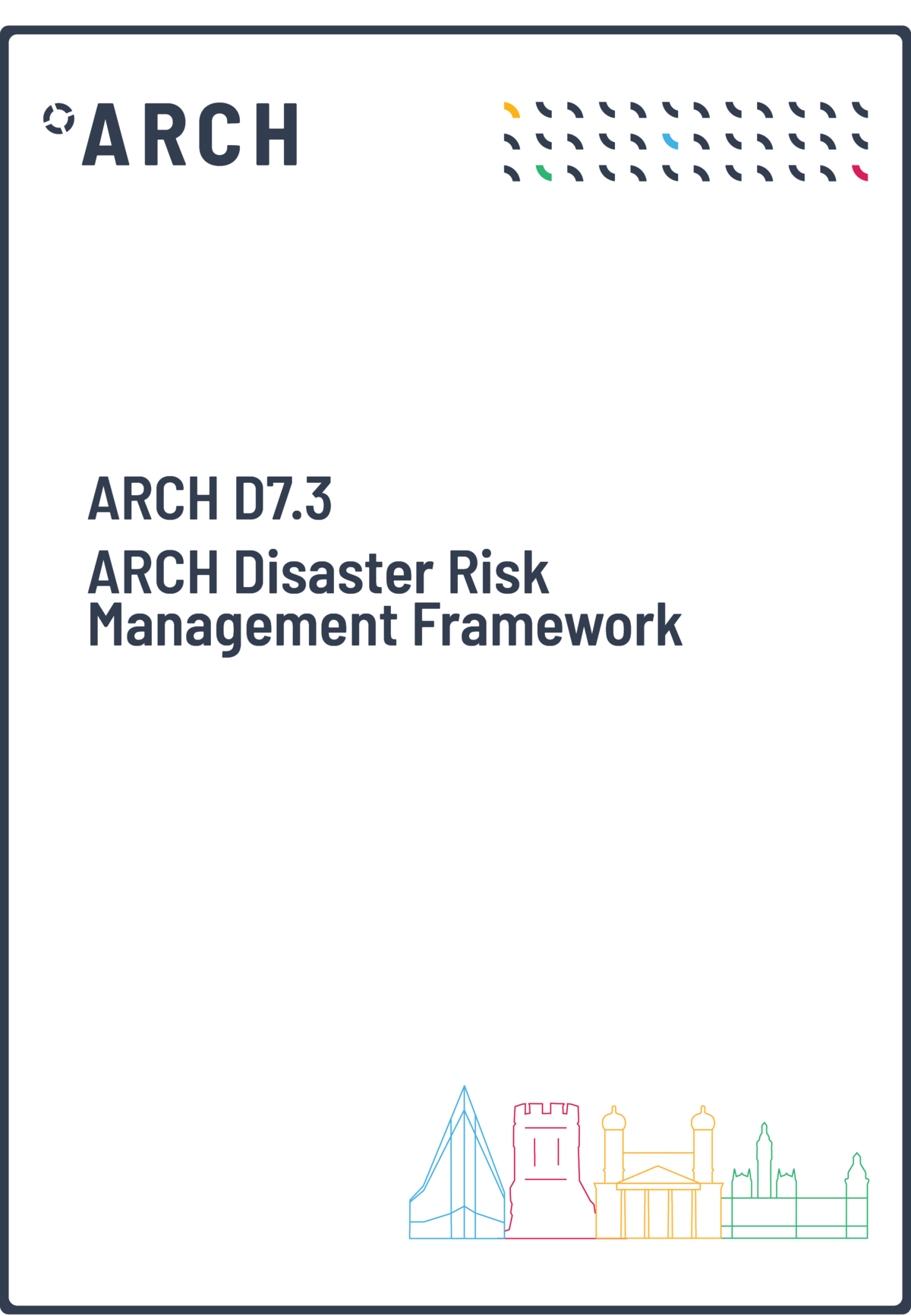
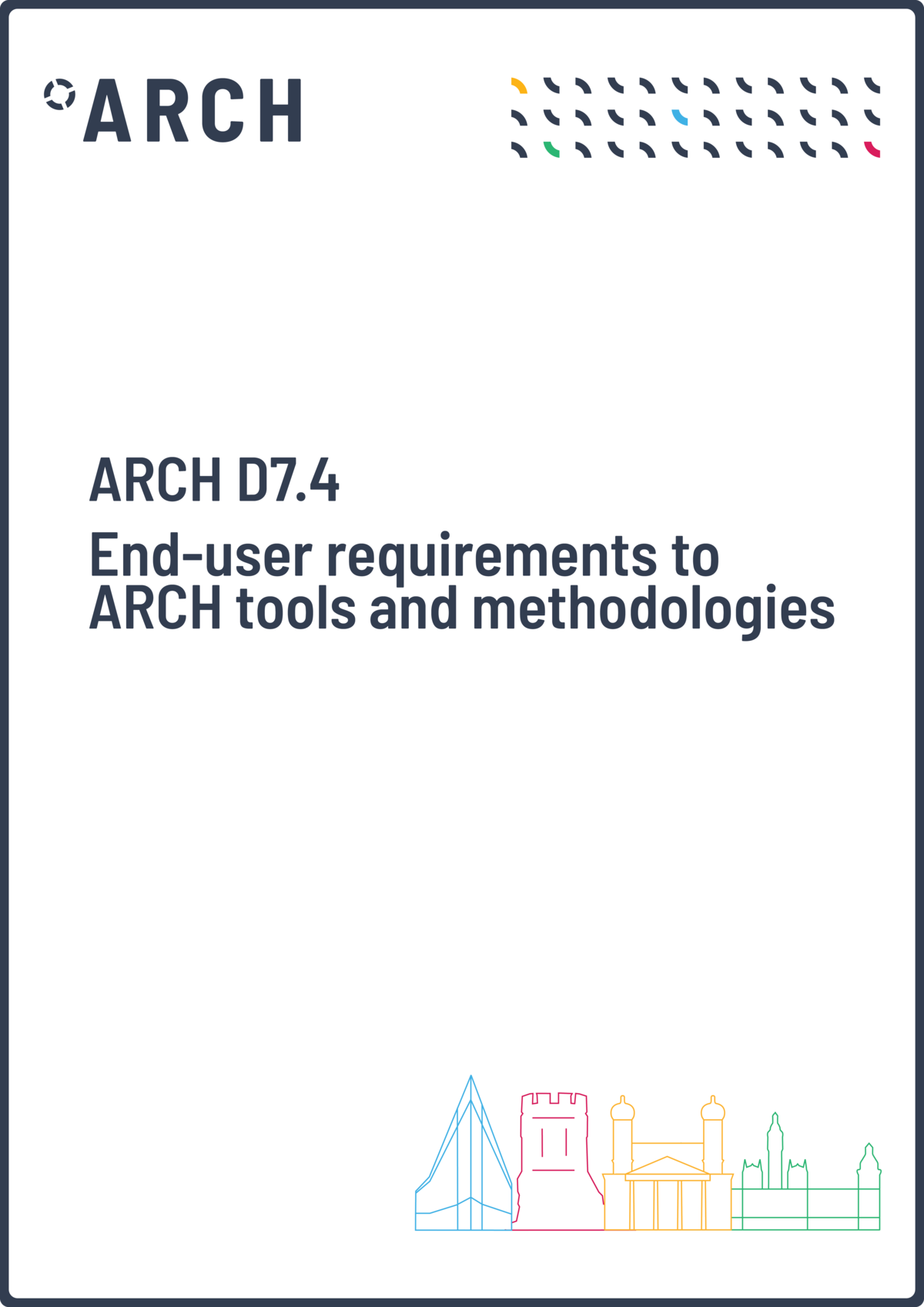
End-user requirements to ARCH tools and methodologies
Deliverable 7.4, May 2020. >Download
ARCH is developing decision support tools and methodologies to improve the resilience of historic areas to climate change-related and other hazards. In order to ensure that these methodologies and tools are in line with the needs of the local end-users and the state-of-the-art, ARCH strives to get an in-depth understanding of the thematic challenges that four cities participating in the project are facing. This report describes the continuous analysis of the local end-user requirements, lists the requirements gathered between November 2019 and April 2020, and presents the initial system specifications of all upcoming ARCH tools.
Authors: K. Nickel, K. Milde, D. Lückerath, E. Rome. Co-authors: S. Giovinazzi, A. Costanzo, A. Krukowski, S. Zorita, M. Mendizabal.

System design, realisation, and integration
Deliverable 7.6, August 2022. >Download
This deliverable describes the development process of the ARCH HUB and ARCH RAD, gives an overview of the resulting tools, how the results of other ARCH WPs are integrated within the ARCH HUB and ARCH RAD. The deliverable also contains the RAD user manual as an annex.
Authors: Katharina Milde, Valerie Wischott, Daniel Lückerath, Stefanie Koslowski, Kylie Wood (Fraunhofer)
